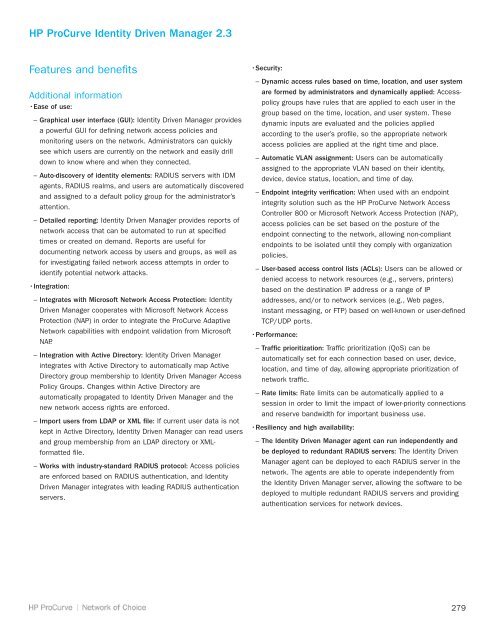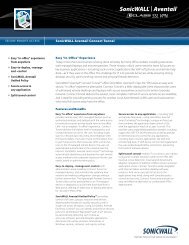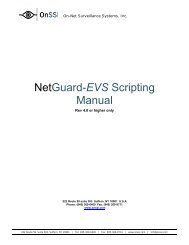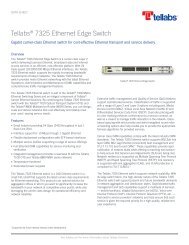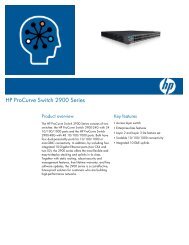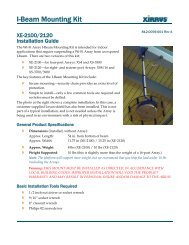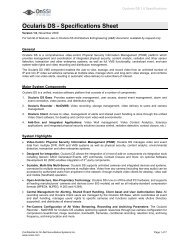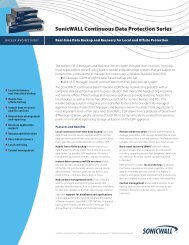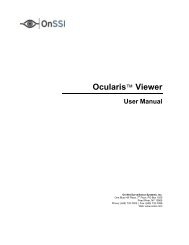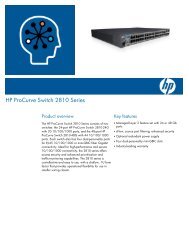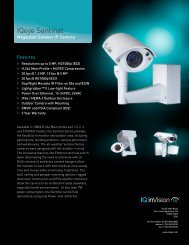HP ProCurve Networking Datasheets - Moonblink
HP ProCurve Networking Datasheets - Moonblink
HP ProCurve Networking Datasheets - Moonblink
Create successful ePaper yourself
Turn your PDF publications into a flip-book with our unique Google optimized e-Paper software.
<strong>HP</strong> <strong>ProCurve</strong> Identity Driven Manager 2.3<br />
Features and benefits<br />
Additional information<br />
• Ease of use:<br />
– Graphical user interface (GUI): Identity Driven Manager provides<br />
a powerful GUI for defining network access policies and<br />
monitoring users on the network. Administrators can quickly<br />
see which users are currently on the network and easily drill<br />
down to know where and when they connected.<br />
– Auto-discovery of identity elements: RADIUS servers with IDM<br />
agents, RADIUS realms, and users are automatically discovered<br />
and assigned to a default policy group for the administrator’s<br />
attention.<br />
– Detailed reporting: Identity Driven Manager provides reports of<br />
network access that can be automated to run at specified<br />
times or created on demand. Reports are useful for<br />
documenting network access by users and groups, as well as<br />
for investigating failed network access attempts in order to<br />
identify potential network attacks.<br />
• Integration:<br />
– Integrates with Microsoft Network Access Protection: Identity<br />
Driven Manager cooperates with Microsoft Network Access<br />
Protection (NAP) in order to integrate the <strong>ProCurve</strong> Adaptive<br />
Network capabilities with endpoint validation from Microsoft<br />
NAP.<br />
– Integration with Active Directory: Identity Driven Manager<br />
integrates with Active Directory to automatically map Active<br />
Directory group membership to Identity Driven Manager Access<br />
Policy Groups. Changes within Active Directory are<br />
automatically propagated to Identity Driven Manager and the<br />
new network access rights are enforced.<br />
– Import users from LDAP or XML file: If current user data is not<br />
kept in Active Directory, Identity Driven Manager can read users<br />
and group membership from an LDAP directory or XMLformatted<br />
file.<br />
– Works with industry-standard RADIUS protocol: Access policies<br />
are enforced based on RADIUS authentication, and Identity<br />
Driven Manager integrates with leading RADIUS authentication<br />
servers.<br />
• Security:<br />
– Dynamic access rules based on time, location, and user system<br />
are formed by administrators and dynamically applied: Accesspolicy<br />
groups have rules that are applied to each user in the<br />
group based on the time, location, and user system. These<br />
dynamic inputs are evaluated and the policies applied<br />
according to the user’s profile, so the appropriate network<br />
access policies are applied at the right time and place.<br />
– Automatic VLAN assignment: Users can be automatically<br />
assigned to the appropriate VLAN based on their identity,<br />
device, device status, location, and time of day.<br />
– Endpoint integrity verification: When used with an endpoint<br />
integrity solution such as the <strong>HP</strong> <strong>ProCurve</strong> Network Access<br />
Controller 800 or Microsoft Network Access Protection (NAP),<br />
access policies can be set based on the posture of the<br />
endpoint connecting to the network, allowing non-compliant<br />
endpoints to be isolated until they comply with organization<br />
policies.<br />
– User-based access control lists (ACLs): Users can be allowed or<br />
denied access to network resources (e.g., servers, printers)<br />
based on the destination IP address or a range of IP<br />
addresses, and/or to network services (e.g., Web pages,<br />
instant messaging, or FTP) based on well-known or user-defined<br />
TCP/UDP ports.<br />
• Performance:<br />
– Traffic prioritization: Traffic prioritization (QoS) can be<br />
automatically set for each connection based on user, device,<br />
location, and time of day, allowing appropriate prioritization of<br />
network traffic.<br />
– Rate limits: Rate limits can be automatically applied to a<br />
session in order to limit the impact of lower-priority connections<br />
and reserve bandwidth for important business use.<br />
• Resiliency and high availability:<br />
– The Identity Driven Manager agent can run independently and<br />
be deployed to redundant RADIUS servers: The Identity Driven<br />
Manager agent can be deployed to each RADIUS server in the<br />
network. The agents are able to operate independently from<br />
the Identity Driven Manager server, allowing the software to be<br />
deployed to multiple redundant RADIUS servers and providing<br />
authentication services for network devices.<br />
279


